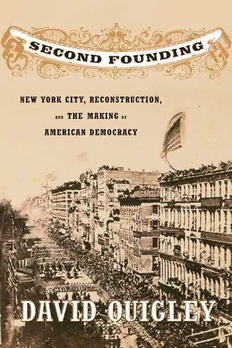
Second Founding: New York City, Reconstruction, and the Making of American Democracy PDF
Preview Second Founding: New York City, Reconstruction, and the Making of American Democracy
SECOND FOUNDING ^ °dfc‘' ogJU*» ^'SÄS8' ^'sSs^ v'efc^ ojjg^ <>5850 opS«* j , rt^?i K^>i *' ( El & * -* * * & + jfp < SECOND FOUNDING &' S *z - *' & New York City, Reconstruction, and * ' u k s <tsl the Making of American Democracy ^ e f <'d c-vs^&faà&âsr* e' & s 8 <'s ^ * s S s ^' k ^ S DAVID QUIGLEY 5$ w <t ^ & U ^J J?! o » 4 . ^ U 4 œ k w k J?Y k f^t kf' ||j|) HILL 1RD WANG k ZS fT ''' A division of Farrar, Straus and Gironx k W New York k f* k fît c- jf Hja* »m» faey'tiy S 3^ ^ab* HjLyA T > "Tr* "Tr* "TP* '■nr '^r -nr "tF :a5r -tF 3* Hill and Wang A division of Farrar, Straus and Giroux 19 Union Square West, New York 10003 Copyright © 2004 by David Quigley All rights reserved Distributed in Canada by Douglas & McIntyre Ltd. Printed in the United States of America First edition, 2004 Library of Congress Cataloging-in-Publication Data Quigley, David, 1966- Second founding : New York City, Reconstruction, and the making of American democracy / by David Quigley.— 1st ed. p. cm. Includes bibliographical references (p. ). ISBN 0-8090-8514-3 (alk. paper) 1. Reconstruction—New York (State)—New York. 2. New York (N.Y.)—History—1865-1898. 3. New York (N.Y.)—Politics and govern ment—To 1898. 4. Democracy—New York (State)—New York—His tory—19th century. 5. New York (N.Y.)—Race relations. I. Title. F128.47.Q54 2004 974.7'1041—dc21 2003012610 Designed by Jonathan D. Lippincott www.fsgbooks.com 1 3 5 7 9 10 8 6 4 2 To Megan CONTENTS Preface ix PART ONE: DEMOCRATIC VISTAS (1863-1866) 1. After the Riots 3 2. Black Founders 15 3. Toward Reconstruction 27 PART TWO: A NEW POLITICS (1866-1874) 4. An Age of Conventions 47 5. Acts of Enforcement 71 6. Liberty and the Postwar City 91 PART THREE: THE ENDS OF RECONSTRUCTION (1874-1880) 7. Tilden’s America 111 8. “The proud name of ‘Citizen’ has sunk” 137 9. New York Reconstructed 161 Epilogue: Grant’s Tomb 175 Notes 187 Bibliography 215 Acknowledgments 225 Index 229 PREFACE The unending tragedy of Reconstruction is the utter inability of the American mind to grasp its real significance, its national and world wide implications. —W. E. B. Du Bois1 This is a book about modern America at its founding moment, the years after the Civil War. Reconstruction, more than any other event in the nation’s past, determined just what kind of politics Americans would have. Back in 1787, America’s first founding had produced a constitution profoundly skeptical of democracy. James Madison and his coauthors in Philadelphia left undecided fundamental questions of slavery and free dom. All that would change in the 1860s and 1870s. Decided at this second founding were the rules of the democratic game. Though lasting only a few short years, Reconstruction involved countless Americans fighting over who would be able to play in that game, and on whose terms. A century and a quarter later, the democracy that emerged at Reconstruc tion’s end remains our inheritance.2 X PREFACE To be sure, the post-Civil War era stands as a most pecu liar founding. It was as much about renouncing the slave re public’s legacies as it was an attempt to establish that rare polity, an interracial democracy. This dialectic of tearing down and rebuilding lies at the conflicted heart of Reconstruction. Slavery had been driven off the American stage, and North and South, East and West, Americans for the first time strug gled over the establishment of a democracy open to all races. Adding to the modernity of this project was the fact that the term democracy itself was no longer anathema, as it had been a century earlier. By 1865, democracy stood as both national ideal and the nation’s institutional arrangements most in need of reconstruction. The second founding, with its lack of a clearly defined cen ter and its heterogeneous character, marks the advent of the modern age in American politics. Early national illustrations of the Philadelphia Convention—depicting elite white men meeting in one city, neatly tucked away from public view— capture well the homogeneity of America’s first founders. Four score years later, Reconstruction could not be similarly con tained; the debate over the second founding raged in the ur ban North, the rural South, and on to the frontiers of the West. And the second founders reflected the ascendant pluralistic America of the late nineteenth century. Frederick Douglass and Elizabeth Cady Stanton were but two of the leading pub lic figures of the day. The reconstruction of democracy occa sioned an unprecedentedly expansive conversation, reflecting an inclusiveness unthinkable in Madison’s day. Decentered, pluralistic, and deeply divided, the second founding speaks directly to contemporary Americans and our politics. In the 1860s and 1870s, this nation for the first time struggled over the substance of an industrializing, urbaniz-
